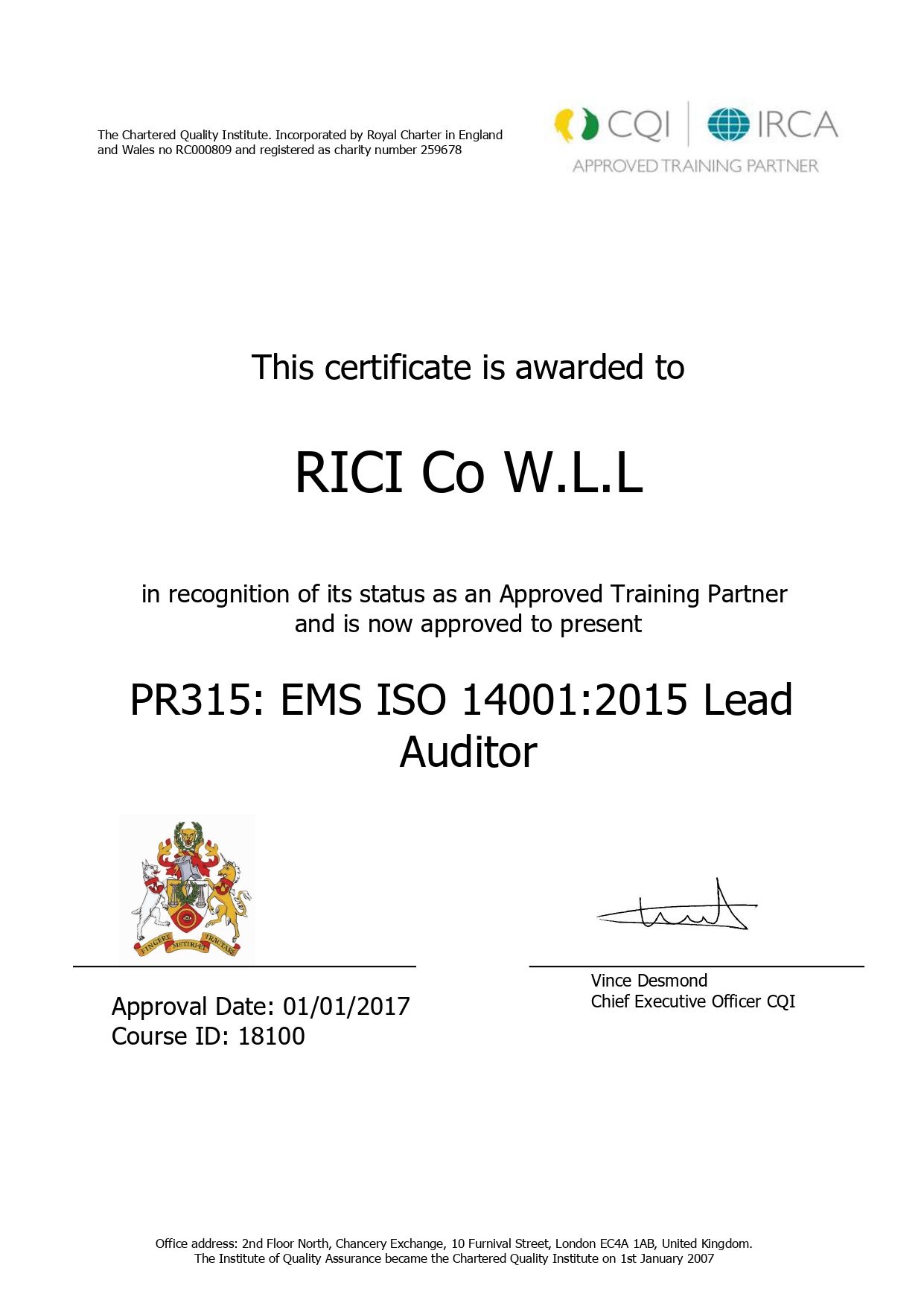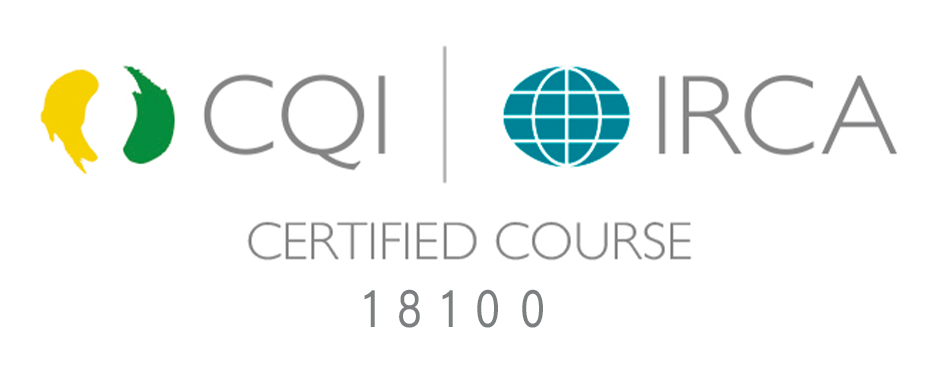How can we help you?
To discover how our services can benefit you, or to receive a free, no commitment quotation, please contact us.
PR315: Environmental Management System ISO 14001:2015 Lead Auditor (CQI and IRCA Course Approval No – 18100)
To make any management system successful, auditing is a very basic and most important element. This course is an intensive and highly rated 5-day program for the preparation of delegates in conducting audits and verifying conformance with ISO 14001:2015; in accordance with ISO 19011. The overall concept of the course is to provide practical and theoretical knowledge of the Environmental Management System with respect to auditing.
ISO 14001 Lead Auditor training enables you to develop the necessary expertise to perform an Environmental Management System (EMS) audit by applying widely recognized audit principles, procedures, and techniques.
During this training course, you will acquire the knowledge and skills to plan and carry out internal and external audits in compliance with the ISO 19011 certification process. Based on practical exercises, you will be able to master audit techniques and become competent to manage an audit program, an audit team, communication with customers, and conflict resolution.
Over 5 days of training, you will learn how to carry out the role of a Lead Auditor, including best practices for auditing, and skills for planning, carrying out, and reporting on an ISO 14001 audit. You’ll learn how to determine the effectiveness of a company’s environmental management system, take the lead in determining auditing processes and lead an audit from inception to completion.
After acquiring the necessary expertise to perform this audit, you can sit for the exam and apply for a CQI and IRCA approved ISO 14001 Lead Auditor credential. By holding a CQI and IRCA approved ISO 14001 Lead Auditor Certificate, you will demonstrate that you have the capabilities and competencies to audit organizations based on best practices.
This course will help candidates in grasping the aims, benefits, and requirements of an ISO 14001:2015 audit and give them the techniques to audit the standard accordingly. On successful completion of ISO 14001 certification, your organization can assure stakeholders that your environmental management system (EMS) meets international industry-specific environmental standards. Every company: large or small; services, industrial, manufacturing, or trade related has an impact on the environment and can, therefore, benefit from ISO 14001 certification.
ISO 14001 requires Environmental Objectives and Targets to be quantitative. In addition, every level of the organization must be examined for incorporation in the Environmental Targets. ISO 14001 requires an organization to utilize the list of significant environmental aspects previously developed and to evaluate the prevention of pollution commitment included in the Environmental Policy statement.
Purpose of an environmental management system
Principles, processes and techniques used for the assessment and management of environmental aspects and impacts
Purpose, contents and interrelationship of ISO 14001:2015, the ISO 14000 series guidance standards and the legislative framework relevant to an EMS
Plan, Conduct report and follow-up an audit in accordance with ISO 19011 and through analysis of ISO 14001:2015
Undertake role of Auditor to Plan, perform conduct and follow up an audit in accordance with ISO 19011; and through analysis of ISO 14001:2015
Organizations seeking to implement an Environmental Management System under ISO 14001:2015
Auditors seeking to perform and lead Environmental Management System (EMS) certification audits
Managers or consultants seeking to master an Environmental Management System audit process
Individuals responsible for maintaining conformance with EMS requirements
Technical experts seeking to prepare for an Environmental Management System audit
Expert advisors in Environmental Management
5 Days
Before attending, it is recommended to have knowledge of the topics listed below:
Quality Management principles and terminologies
PDCA Cycle (Plan, Act, Check, Act)
Requirements & structure of ISO 14001 standard
To discover how our services can benefit you, or to receive a free, no commitment quotation, please contact us.
| Test No. | Test Name | ASTM Standard Method | BS Standard Method |
|---|---|---|---|
| 2 | Sampling Freshly Mixed Concrete | ASTM C172 | BS EN 12350-1 |
| 3 | Temperature of Freshly Mixed Hydraulic-Cement Concrete | ASTM C1064 | - |
| 4 | Slump of Hydraulic-Cement Concrete | ASTM C143 | BS EN 12350-2 |
| 5 | Density (Unit Weight), Yield, and Air Content (Gravimetric) of Concrete | ASTM C138 | BS EN 12350-6 |
| 6 | Air Content of Freshly Mixed Concrete by the Pressure Method | ASTM C231 | BS EN 12350-7 |
| 7 | Making and Curing Concrete Test Specimens in the Field | ASTM C31 | BS EN 12390-1/2 |
| 8 | Density of Hardened Concrete | - | BS EN 12390-7 |
| 9 | Water Storage Tanks Used in the Testing of Hydraulic Cements and Concretes | ASTM C511 | - |
| 10 | Capping Cylindrical Concrete Specimens | ASTM C617 | - |
| 11 | Compressive Strength of Cylindrical/ Cubical Concrete Specimens | ASTM C39 | BS EN 12390-3 |
| Serial Number | Test Name | ASTM Standard Method | BS Standard Method |
|---|---|---|---|
| 1 | Sampling Aggregates | ASTM D75 | BS EN 932-1 |
| 2 | Reducing Samples of Aggregate to Testing Size | ASTM C702 | BS EN 932-2 |
| 3 | Aggregate Moisture Content | - | BS 812-109 |
| 4 | Sieve Analysis of Fine and Coarse Aggregates | ASTM C136 | BS EN 933-1 |
| 5 | Material Finer than 75-µm Sieve and 63-µm Sieve in Aggregates by Washing | ASTM C117 | BS EN 933-2 |
| 6 | Clay Lumps and Friable Particles in Aggregates | ASTM C142 | - |
| 7 | Degradation of Coarse Aggregate by Abrasion and Impact in the Los Angeles Machine | ASTM C131 / C535 | - |
| 8 | Soundness of Aggregates by Use of Sodium Sulfate or Magnesium Sulfate | ASTM C88 | BS 812-121 |
| 9 | Density, Relative Density (Specific Gravity), and Absorption of Coarse Aggregate | ASTM C127 | BS EN 1097-6 |
| 10 | Density, Relative Density (Specific Gravity), and Absorption of Fine Aggregate | ASTM C128 | BS EN 1097-7 |
| Serial Number | Test Name | ASTM Standard Method |
|---|---|---|
| 1 | Standard practice for sampling bituminous paving mixtures | ASTM D979 |
| 2 | Standard test method for moisture or volatile distillates in bituminous paving mixtures | ASTM D1461 |
| 3 | Standard test method for theoretical maximum specific gravity and density of bituminous paving mixtures | ASTM D2041 |
| 4 | Standard test method for quantitative extraction of bitumen from bituminous paving mixtures | ASTM D2172 |
| 5 | Standard test method for bulk specific gravity and density of non-absorptive compacted bituminous mixtures | ASTM D2726 |
| 6 | Standard practice for estimating application rate of bituminous distributors | ASTM D2995 |
| 7 | Standard test method for percent air voids in compacted dense and open bituminous paving mixtures | ASTM D3203 |
| 8 | Standard test method for thickness or height of compacted bituminous paving mixtures specimens | ASTM D3549 |
| 9 | Standard practice for sampling compacted bituminous mixtures for laboratory testing | ASTM D5361 |
| 10 | Standard test method for mechanical size analysis of extracted aggregate | ASTM D5444 |
| 11 | Standard practice for preparation of bituminous specimens using Marshall apparatus | ASTM D6926 |
| 12 | Standard test method for Marshall stability and flow of bituminous mixtures | ASTM D6927 |

